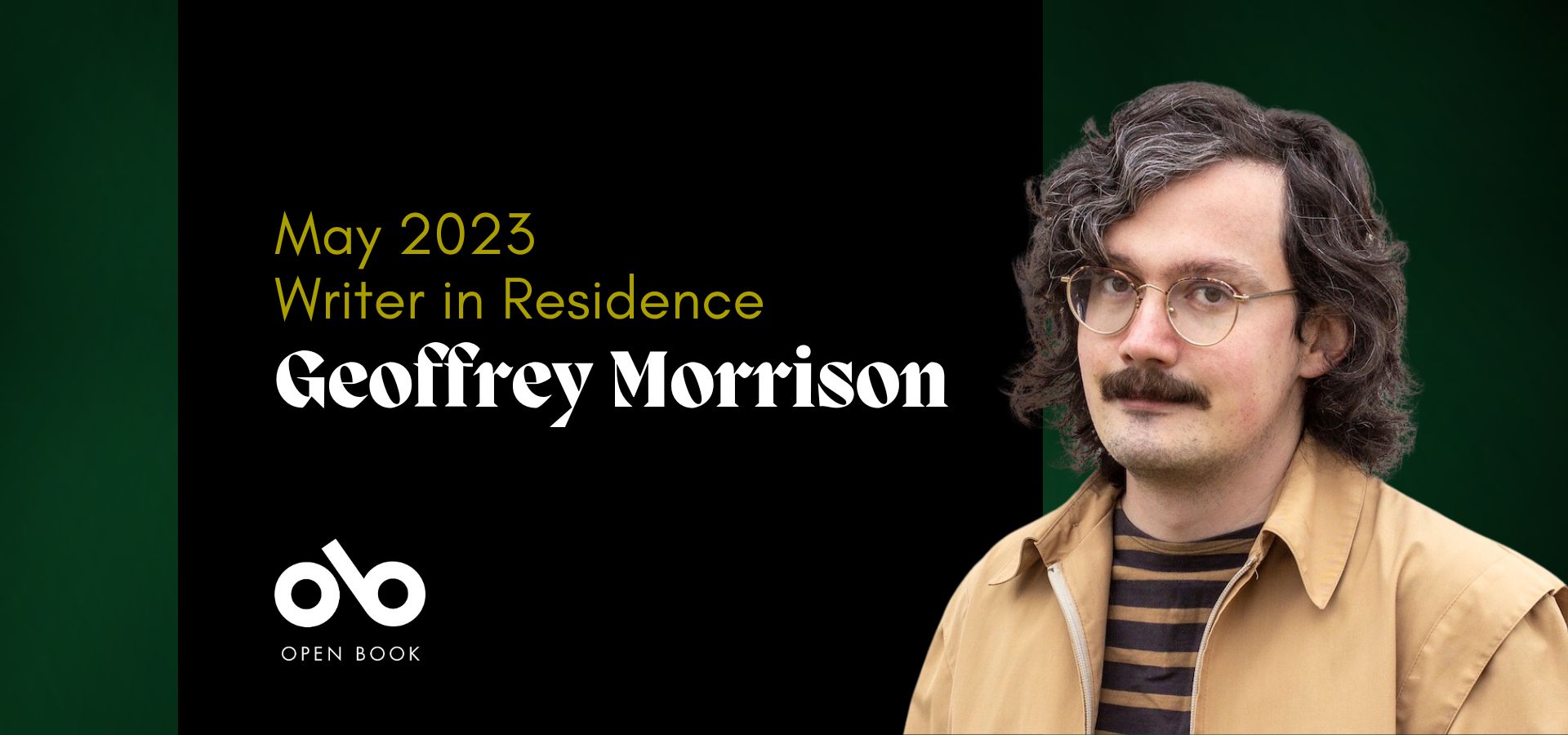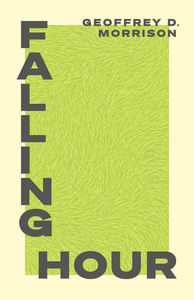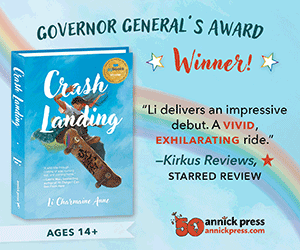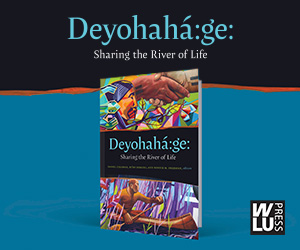May 2023 Writer in Residence Geoffrey Morrison on the 7 Words That Sparked His Captivating Debut Novel
In a strangely deserted public park, Hugh Dalgarno is falling apart. Through an entire day and night, his fevered mind will take him, and anyone along for the ride, on a rollicking interior journey, touching on everything from the CIA to quantum immortality, contemplating characters as diverse as Louis Riel and Gene Hackman. All this is set to a background track of Irish rebel tunes, Scottish folk ballads, and the call of the red-winged blackbird.
A narrative that could be dizzying in other hands is held fast by Geoffrey D. Morrison in Falling Hour (Coach House Books), a virtuosic debut novel that takes readers inside 31-year old Hugh's frankly fascinating head. Written in a style reminiscent of W.G. Sebald's hybrid literature triumph The Rings of Saturn, Falling Hour is wise and wry, history-obsessed and insightful. Hugh's spiralling thoughts are disorienting to him but captivating to the reader as he weaves through histories of resistance, whether political, literary, or philosophical.
Surreal, raw, and smart, it's a singular debut and one we're excited to talk about with Geoffrey as we welcome him to Open Book as our May 2023 writer in residence. Throughout the month, he will share original writing on our writer in residence page – don't miss the chance to hear directly from one of the year's most exciting debut authors.
In our discussion, he tells us about the seven words that sparked the novel's direction for him, the city that inspired his setting and its complicated past, and the two people without whom Falling Hour could not have come to be.
Open Book:
Do you remember how you first started this novel or the very first bit of writing you did for it?
Geoffrey Morrison:
Before Falling Hour, I had tried to write a historical fiction in the style of Hilary Mantel. In trying and failing, I realized I was getting caught up in the minds of my characters, to the exclusion of events. So I thought I would try again with a solitary historical figure whose life was largely devoid of events. I settled on Spinoza, whose daily life was mostly spent grinding optical lenses for money, a task which ultimately killed him when the fine silicate particles overwhelmed his lungs. So my first file of notes for what became Falling Hour was called “Spinoza.” But the more I researched, the less I wanted to write about Spinoza. His misogyny, for instance, was severe even for his time. There are of course many thoughtful authors who inhabit the minds of characters they disagree with, but in my case I realized I wanted to inhabit a fictional mind more congenial to mine.
Reviewing those old notes, I’m somewhat shocked to see that I wrote down, all by itself, “a concrete city in a green world.” Everything really seems to have flowed from those seven words. My very first efforts are mostly preserved on the first page or two of Falling Hour: an overhead view, concrete cubes, a park, and a person somewhat oddly playing around with a picture frame. At first I didn’t know Hugh was Hugh, or from Aberdeen in Scotland like my mother, or that he thought his brain was broken, but as a certain voice came to the surface I quickly saw these things had to be so. Within a few months (I wrote slowly at the start) I had material that would ultimately become the first two chapters, some backstory that, with some tweaking, appeared later, an early effort to describe a scene from the film The Conversation, and a certain ornithological coincidence involving the family of John Keats that I quickly realized must go at the very end of the book.
I think Hugh’s frame is the last, ghostly vestige of my initial idea to do something with lenses. Lenses, frames – these are literally things we look through, and also metaphors for the arrangement of thoughts.
OB:
How did you choose the setting of your novel? What connection, if any, did you have to the setting when you began writing?
GM:
I went to London, Ontario to do a Master’s degree when I was 22. I got a scholarship that made it possible to go. It was my first time on a plane since I was three, and my first time in another province in Canada. Everything was different from Coastal BC. Humidity. Snowblowers. Fireflies. Snakes in the grass. Being in a new place meant I saw everything – even things whose equivalents I had seen at home – with new eyes. There was a political dimension to this.
Your CanLit News
Subscribe to Open Book’s newsletter to get local book events, literary content, writing tips, and more in your inbox
Part of the reason I was at UWO was to take a seminar on Finnegans Wake with Michael Groden. As it happened this was his last grad seminar before he retired. He was a very lovable teacher. Reading Joyce and thinking about Ireland’s subjugation by Britain was an eerie thing to do in London, Ontario. The town’s place names and monuments are a loathsome ongoing tribute to British imperialism and Protestant hegemony. In Victoria Park there is a statue of a soldier in a pith helmet. I was aghast when I saw it. It names places local men fought in the Boer War. One of them is “BELFAST.”
I was only there for a year, but the experience stayed with me. And the town in Falling Hour is basically London, Ontario, but with a handful of differences. The fire hydrants in this town are red. There is an intersection called Wellington and Boyne. The real London, ON has yellow hydrants and no street called Boyne.
The area surrounding the park in Falling Hour, which Hugh calls “Dice-Town” or “Craps-Town,” is very much based on the area around London’s Victoria Park. The wrought-iron gates at its entrance are likewise the same. However, Victoria Park is one of those 19th-century parks in the style of a lawn or a garden, and parts of the Falling Hour park have more the feel of a woodland. I was thinking of places in BC like Central Park in Burnaby, Crescent Park in Surrey, or Trout Lake in Vancouver. So the park is basically impossible – a Pacific woodland inside of an Ontario garden.
Finally, the story is explicitly set in the year 2019. I wrote most of this book in 2020, and wasn’t sure what life would look like after Covid, or if there would even be an “after.” I thought it would be more interesting to have a character unwittingly awaiting a global crisis, rather than living through it as everyone was at the time. And as it happened, I would find many coincidences and quasi-numerological oddities that would also justify my choice after the fact.
OB:
Did the ending of your novel change at all through your drafts? If so, how?
GM:
The Keats family coincidence which I mentioned earlier always stayed where it was. And the final sentences of the book remained largely unchained, excepting a few small tweaks to make it clearer what I was on about. But some other things did change.
I couldn’t have dreamed of a better editor than André Alexis, and one of the most incisive things he said was that the first draft of my second-to-last chapter was trying too hard to induce the feeling of a “dramatic” ending. He really had my number because I truly had assumed I needed special pyrotechnics to close things out. Hugh got scared and ran around in terror. There was even a ghost! It was all quite forced. So all that stuff went away and the tone became more one of acceptance than fear.
André also pointed out that Hugh ending up in a public toilet, which in my first draft I really played up as a gross, stinky place, was actually kind of a stock device. In my rewrite, Hugh’s whole attitude to the toilet shack was changed. It became a “concrete cottage” and “thinking room” described in quite tender terms – a fitting anteroom to wherever it is he is now.
OB:
Did you do any specific research for this novel? Tell us a bit about that process.
GM:
So much research. I researched as I went. I read Keats letters, ornithological manuals, court cases, 19th-century Scottish agricultural histories, 19th-century philosophies of mind, passenger manifests of Hebridean emigrants, old censuses, old obituaries, accounts of Thomas Muir’s escape from prison, accounts of the United Irishmen, letters and treatises by Ada Lovelace, letters by Louis Riel, Rosa Luxemburg’s last article, Marx on surplus value, Gramsci on detective stories, Virginia Woolf on Joyce, Byung-Chul Han on beauty, David Lewis on quantum immortality, dying-and-rising gods…
OB:
Who did you dedicate your novel to, and why?
GM:
The novel is dedicated to my maternal grandparents, Molly Mortimer (née Dalgarno) and Robert Wilson Mortimer. They were both from the Northeast of Scotland. Molly grew up in Woodside in Aberdeen. Her father was a wool spinner and her mother was a millworker. Molly worked in several different shops, cooked and cleaned for a doctor’s family, and was also a dispatcher for the fire department. Bob’s parents were small farmers. He grew up on several different tenant farms in Aberdeenshire, mostly in the Inverurie and Oldmeldrum area, but also in the Mearns. For most of his life he drove a lorry on long-distance hauls, and when he got older he worked as a porter in a university library and a hotel.
My parents took me to Scotland to visit them when I was three, and they also visited us in Canada several times while I was a child. When Bob died, Molly came to live with us in Canada. Molly is, incredibly, still alive at 106 years of age.
The great-aunt and great-uncle characters in Falling Hour are based on Bob and Molly to some extent, and of course Hugh’s surname is Molly’s maiden name. As older parents, they passed on to my mother older ways of doing things, older songs and stories, older forms of the Doric dialect of Scots. Inevitably I absorbed some of the same things, albeit in the attenuated way you do when you live in another place. This book would literally be unthinkable without them.
OB:
Did you include an epigraph in your book? If so, how did you choose it and how does it relate to the narrative?
GM:
I have two epigraphs. The first is a remark from Marx in his posthumously published Theories of Surplus Value: “Milton produced Paradise Lost for the same reason that a silkworm produces silk. It was an activity of his nature.” It’s kind of an oddly beautiful way to formulate what an artist is doing. Almost like science fiction. It stirs me. And I was thinking about it often as I wrote this novel because, truly, I did not know if anyone would care to read such a strange thing but me. It was an activity of my nature.
My second epigraph is a pair of lines from “The Bonnie Lass o’ Fyvie,” a song I heard my mother singing growing up and which becomes important for Hugh: “Green grow the birks on bonnie Ythanside / And low lie the lowlands of Fyvie-o.” I partly picked these lines because the word “green” is such a motif for me in the book. André pointed out to me that I use it something like 85 times.
_______________________________________________
Geoffrey D. Morrison is the author of the poetry chapbook Blood-Brain Barrier (Frog Hollow Press, 2019) and co-author, with Matthew Tomkinson, of the experimental short fiction collection Archaic Torso of Gumby (Gordon Hill Press, 2020). He was a finalist in both the poetry and fiction categories of the 2020 Malahat Review Open Season Awards and a nominee for the 2020 Journey Prize. He lives on unceded Squamish, Musqueam, and Tsleil-Waututh territory (Vancouver).




